Bear den surveys reflect influence of summer drought
ON 03-29-2023
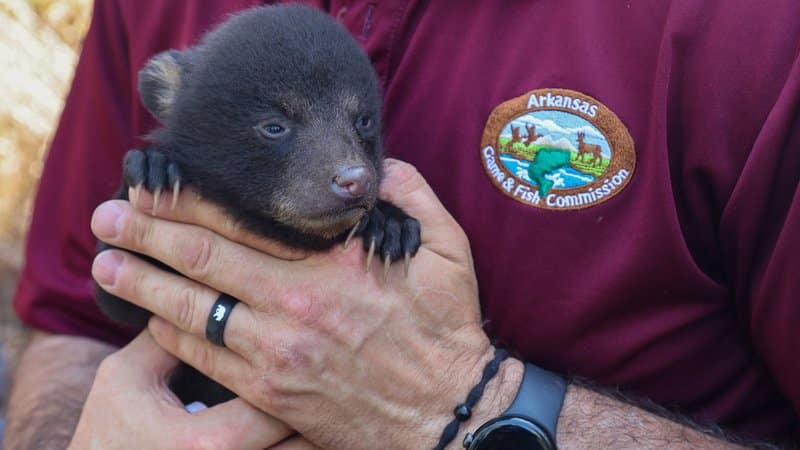
March 29, 2023
Randy Zellers
Assistant Chief of Communications
WALDRON — Last summer’s drought may have some lingering impact on Arkansas’s black bear reproduction, but there’s no immediate cause for alarm, according to Myron Means, the Arkansas Game and Fish Commission’s large carnivore program coordinator.
Each year Means works with biologists and technicians from the AGFC’s Wildlife Management and Research divisions during February and March to visit female bears at their dens and evaluate their condition and the condition of their cubs to identify trends that may impact the entire population.
“We try to maintain about 60 female bears with radio collars throughout the state to help us with our monitoring work,” Means said. “Of those, about half will be with yearlings and the other half will have cubs with them in their dens.”
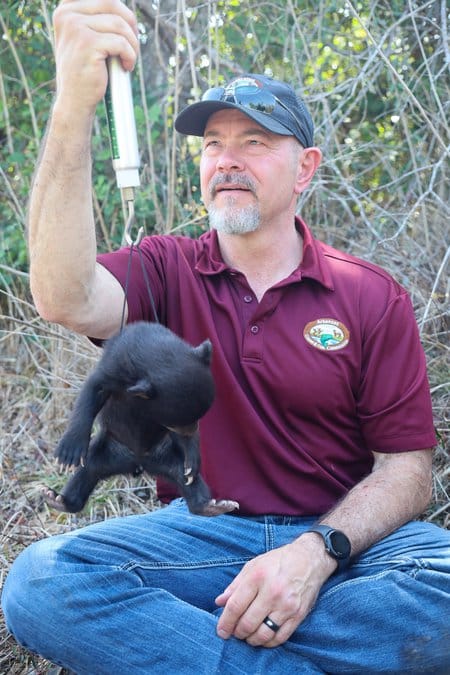
Means explains that female bears typically take two years to have and raise their young. During the first winter, the sows will have their cubs with them and allow them to nurse. Those cubs will stay with the mother throughout the year and through the next winter “learning to be bears.” Upon emerging from their second denning cycle, the yearlings will be pushed from the mother’s home.
“She’ll actually let her female yearlings stay in a part of her home range, but she’ll push the males out,” Means said. “That does two things:it ensures that her female cubs have a good place that provides adequate food and resources, and it prevents issues that can arise from inbreeding. It’s one of those ways Mother Nature works that’s just really interesting.”
Typically, a female black bear is sexually mature at 3-5 years old. Arkansas bears tend to begin reproducing at age 3 or 4. They can have cubs until they are around 20 years old. That gives them 16 years of opportunity to reproduce.
“But with an every-other-year cycle, we’re really only looking at raising young eight times at most,” Means said. “With the average litter size being two cubs, a female bear will produce about 16 cubs if she survives throughout a bear’s typical natural lifespan.”
This fascinating two-year reproductive cycle also means biologists must keep constant tabs on the population, as it is much slower than other game species in Arkansas.
“We have much fewer bears than deer and other game, and they reproduce much more slowly, so we really want to identify trends as soon as possible,” Means said. “That means we really need to keep a close eye on reproduction each year. If you overharvest bears, it can take a long time to recover. We have different regulations and season frameworks that can help prevent that if we have this annual data.”
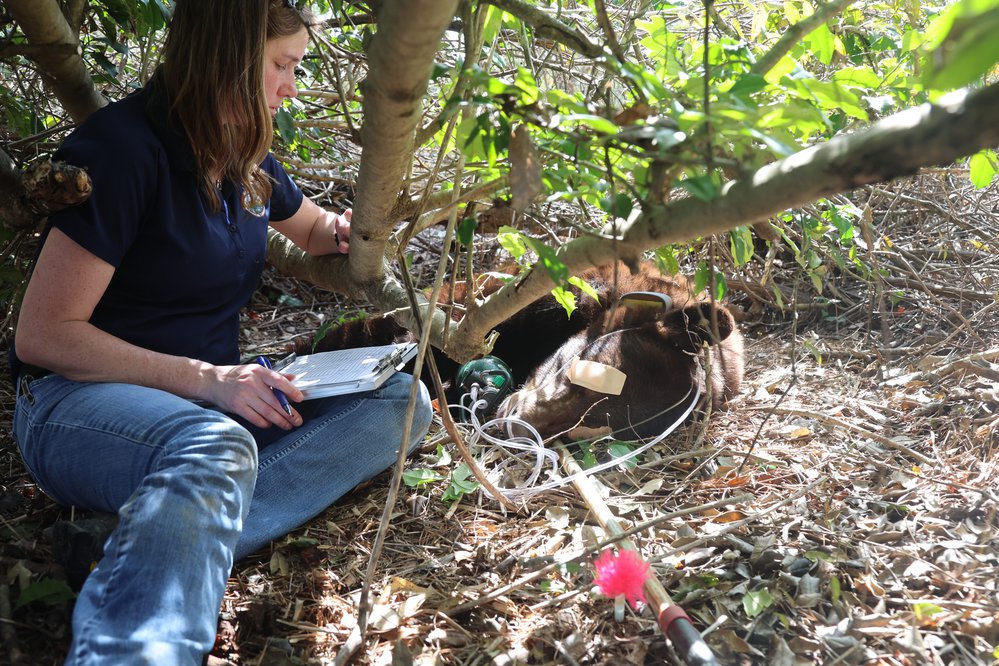
The process of bear den monitoring actually begins in summer when biologists and technicians across Arkansas’s bear range set and monitor snare traps to catch bears they are seeing on game cameras and during their work on wildlife management areas. They sedate the bears, take their measurements and outfit them with radio collars. Each collar has a signal emitter that biologists can later use to locate the bear using special equipment. It can take days of driving and hiking to discover exactly where a female bear has decided to make her den for the winter.
“Our south Arkansas bears were given GPS collars, which give locations a bit easier,” Means said. “Those are much more expensive, so the majority of our collared bears still use the radio-signal version for now.”
Biologists look for the dens in late winter and have a list of bears that should be with cubs to visit. They will quietly approach the mother bear and again sedate her using a special mix of chemicals.
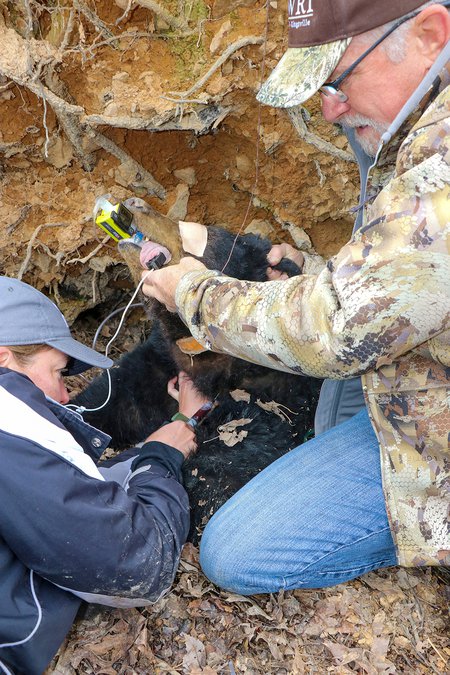
“We’re actually working with researchers from Texas testing a new drug for the trips,” Means said. “The previous drugs we used were highly monitored by regulatory agencies, and this one should be safer for the bears. It has the ability to be reversed. This lets the mother bear get back to the business of raising her cub as soon as we’re gone.”
Despite popular belief, Means says bears aren’t true hibernators. Many animals like groundhogs can lower their body processes – for example, pulse rates and breathing rates – to the point they are catatonic. It can take several hours for a hibernating animal to rouse from this state. This is not the case with a mother bear.
“She’ll lower her heart rate and breathing rate as well as other bodily functions during the winter denning cycle, but not to that catatonic state,” Means said. “If she sees, hears or smells an intruder, she can instantly respond. Just about every bear we approach in our research will be awake when we arrive to sedate her.
So far this year the bears in the Ozarks and Ouachitas have shown reproductive rates at roughly 45 percent of what they typically record. While this might be cause for concern, Means says the bear population is still very healthy and should be able to withstand one poor year of reproduction.
“We’re seeing sows without cubs and sows with only one cub,” Means said. “The female bears and the cubs produced are in good condition, there are just less cubs this year. “That’s normally an indication of poor habitat quality during the first few months of the bear’s reproductive cycle.”
Means says that although breeding takes place in spring, the bear’s body can reject the pregnancy if conditions are not good.
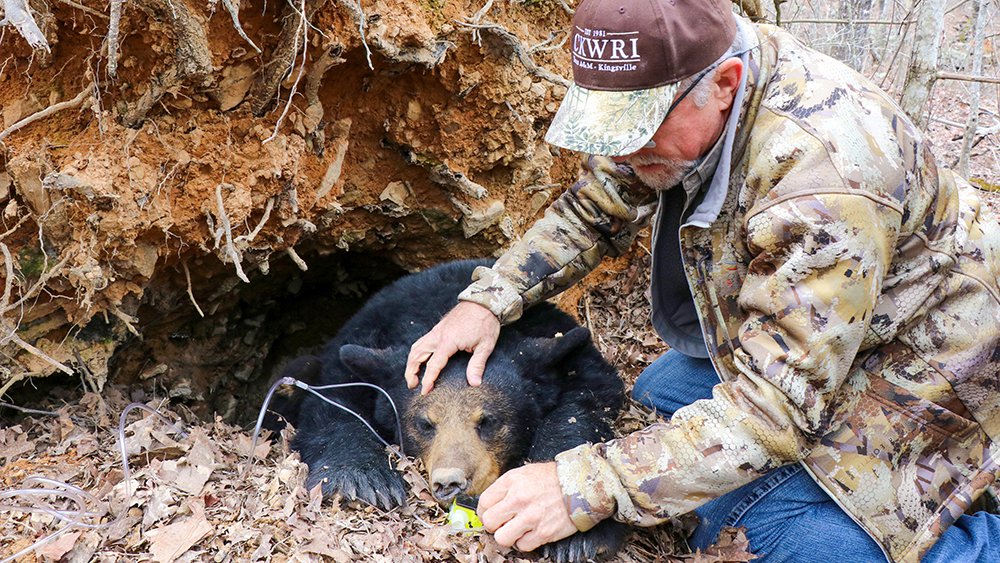
“Last year’s drought hit the berry crop hard in the northern half of the state, reducing the amount of wild blackberries and wild cherries these female bears would normally have been eating. But the acorn crop was good, so those bears who did have cubs recovered quickly and are showing very good health. The drought conditions weren’t as bad in the southern half of the state, and we had a really good berry crop in the Gulf Coastal Plain. Those bears continue to show good reproduction.”
Check out a recent segment of Arkansas Wildlife Television covering the AGFC’s bear den research and the greatest comeback of a large carnivore in history.
CUTLINES:
Bear cub (horizontal)
The AGFC visits dozens of female bears during late winter to measure cub production and survival.
Man measuring bear cub (vertical)
AGFC Large Carnivore Program Coordinator Myron Means weighs a bear cub in south Arkansas during this year’s bear den visits.
Woman and man working with bear (vertical)
Dr. Carrie Ullmer of the Texas State Aquarium takes a blood sample from a sedated bear.
Woman monitoring bear (horizontal)
AGFC Wildlife Health Biologist A.J. Riggs keeps an eye on a healthy mother bear while it’s sedated for research work.
Man with bear (horizontal)
Dr. Clay Hilton of Caesar Kleberg Wildlife Research Institute monitors a sedated bear.
Recent News

Schoenrock chosen to lead AGFC
Apr. 21, 2025

AGFC Commissioner Meeting Notice
Apr. 21, 2025
Subscribe to Our Weekly Newsletter E-mails
Don’t miss another issue. Sign up now to receive the AGFC Wildlife Weekly Newsletter in your mailbox every Wednesday afternoon (Waterfowl Reports are published weekly during waterfowl season and periodically outside the season). Fishing Reports arrive on Thursdays. Fill in the following fields and hit submit. Thanks, and welcome!
